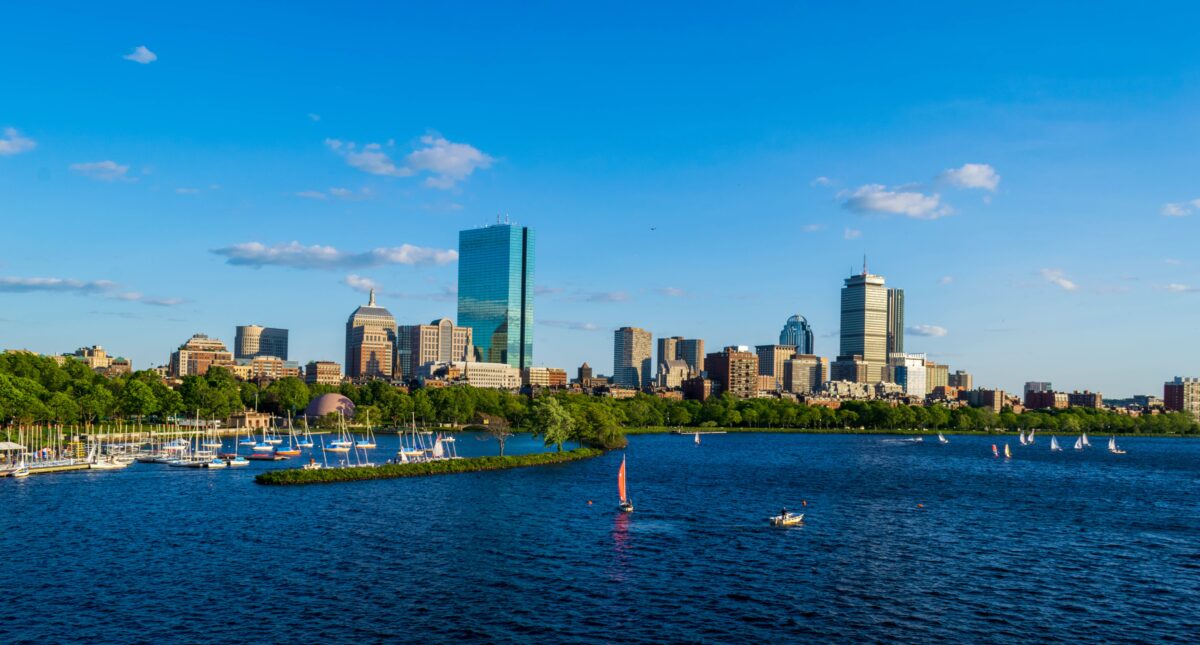Many Bostonians take pride in the Charles River, observing the fireworks in the summer and foliage in the fall. But is the river suitable for more than admiration from afar?
The Charles River runs through Eastern Massachusetts into Boston. It currently has a “B” water quality grade, which means it is safe for all boating activities and some swimming activities. Although it is still a long way from being completely void of health and safety hazards, the B grade is a major improvement from past years when the river was so polluted it barely resembled a body of water. In a 1955 Harper’s Magazine article, the river was deemed “foul and noisome, polluted by offal and industrious wastes, scummy with oil, unlikely to be mistaken for water.” The river’s color was even occasionally tinted pink and orange from excess amounts of toxic chemicals. In 1995, after many years of subpar water quality, the EPA finally decided on a goal of making the river swimmable by 2005 and began sampling the river for quality. That year, it received a D rating, much worse than today.
During dry weather events in 2018, 94% of water samples met Massachusetts’s standards for boating and 66% met its standards for swimming. In 1995, only 39% of the samples met Massachusetts’s quality standards and 19% met swimming standards. Unfortunately, this is a slight drop from 2017, when the river achieved an A- grade, but experts believe the drop could be a product of record rainfall in 2018. Although the EPA’s goal of making the Charles completely swimmable by 2005 was not achieved, it has still made significant progress toward this goal. Swimming races are now occasionally held in the river, as well as annual “City Splash” events where the public can sign up to swim in a designated clean area of the river. In fact, the Charles River Conservatory is even working to install a permanent swimmable dock despite the expenses of a project of this magnitude.
Although these are major improvements from 1995, there is still work to be done to make the river a clean space for all, and to ensure it doesn’t drop in quality. Bacterial levels have decreased in recent years, but algal blooms are increasingly becoming a problem in the river. Runoff from storm events often bring an excess of phosphorus into the river, causing levels of toxic cyanobacteria to increase. Emily Norton, the CWRA executive director, wrote: “The B grade is a reminder that while the Charles is much cleaner than it was when the first grade was given—a D in 1995—our work is far from over. Today the biggest challenges facing the river are stormwater runoff, [sic] and extreme weather from climate change.” With increased storm events caused by climate change, it is important to improve water quality to counteract these issues. This is especially pertinent when the weather is wet, since polluted runoff from storms and sewer overflows can decrease water quality, a fact any hopeful paddleboard renter will hear at Charles River Canoe and Kayak after being told they cannot rent on the day after a storm.
Organizations and the public must collaborate to improve the river’s quality. For example, to raise awareness of the river’s pollutants, former governor William Weld jumped into the river in 1996. In addition, some activities have a more scientific focus. The EPA set up a buoy that measures water quality in the Museum of Science to inform the public on these issues. Communities are working to reduce stormwater runoff by giving municipalities an MS4, or Municipal Separate Storm Sewer System permit, which instructs towns and cities on how to reduce runoff from storms. As a result, water quality has drastically improved since 1995 as sewage discharges are discharged less into storm drain systems and CSOs (Combined Sewer Overflows), which were depositing polluted runoff into the river. A 57 inch pipe was recently installed to improve waste flow to Deer Island, where a treatment plant was set up, as well as to reduce overflow from rainstorms. Overall, many methods have been implemented in recent years to improve water quality.
The Charles is home to a variety of species and provides numerous recreational and drainage services for Boston, so working to keep it clean is crucial. The public can help by disposing of toxic waste properly; practicing mindful, proper, and minimal use of fertilizers to minimize runoff; and cleaning up litter and pet waste to avoid contaminating the river. People can also volunteer to clean up trash in or along the river, which is an easy way to get involved. For those with more time and resources, rain barrels or gardens can be installed in homes to reduce runoff, flooding, and erosion into the river. It is possible to make both contraptions at home, so this isn’t necessarily too expensive. Although the quality of the river has drastically improved in the past twenty-five years, the effects of climate change, such as increased storm events, mean that the Greater Boston community must continue to work to make the river a safe place for all.
Sources:
12 Things You Can Do to Clean Up Your Rivers, Streams, and the Chesapeake Bay. (n.d.). Retrieved October 09, 2020, from https://www.cbf.org/join-us/more-things-you-can-do/12-things-you-can-do-to-clean.html
Bender, E. (2019, June 12). Charles River water quality earns a “B” for bacterial sampling conducted in 2018. Retrieved October 09, 2020, from https://www.epa.gov/newsreleases/charles-river-water-quality-earns-b-bacterial-sampling-conducted-2018
The Charles River Initiative. (2020, April 16). Retrieved October 09, 2020, from https://www.epa.gov/charlesriver/charles-river-initiative
Charles River Watershed Cleanup. (n.d.). Retrieved October 09, 2020, from https://www.crwa.org/cleanup.html
DeFusco, J. (2017, July 18). Bostonians Take A Dip In ‘That Dirty Water’. Retrieved October 09, 2020, from https://www.wbur.org/news/2017/07/18/bostonians-swim-charles-river
DeLuzuriaga, T. (2008, April 26). Retrieved October 09, 2020, from http://archive.boston.com/news/local/articles/2008/04/26/love_that_dirty_water_now_its_getting_better/
From the Archives: Gov. Weld dives into the Charles River. (1996, August 08). Retrieved October 09, 2020, from https://www.patriotledger.com/article/19960808/NEWS/308089999Wasser, M. (2019, June 12). Charles River Report Card Drops From A- To B. What Happened To Water Quality In 2018? Retrieved October 09, 2020, from https://www.wbur.org/earthwhile/2019/06/12/charles-river-water-quality-report-card-2018

